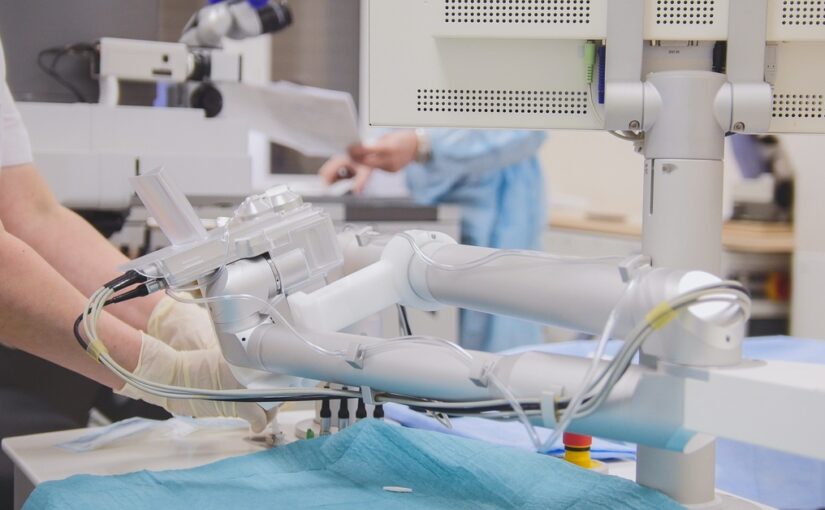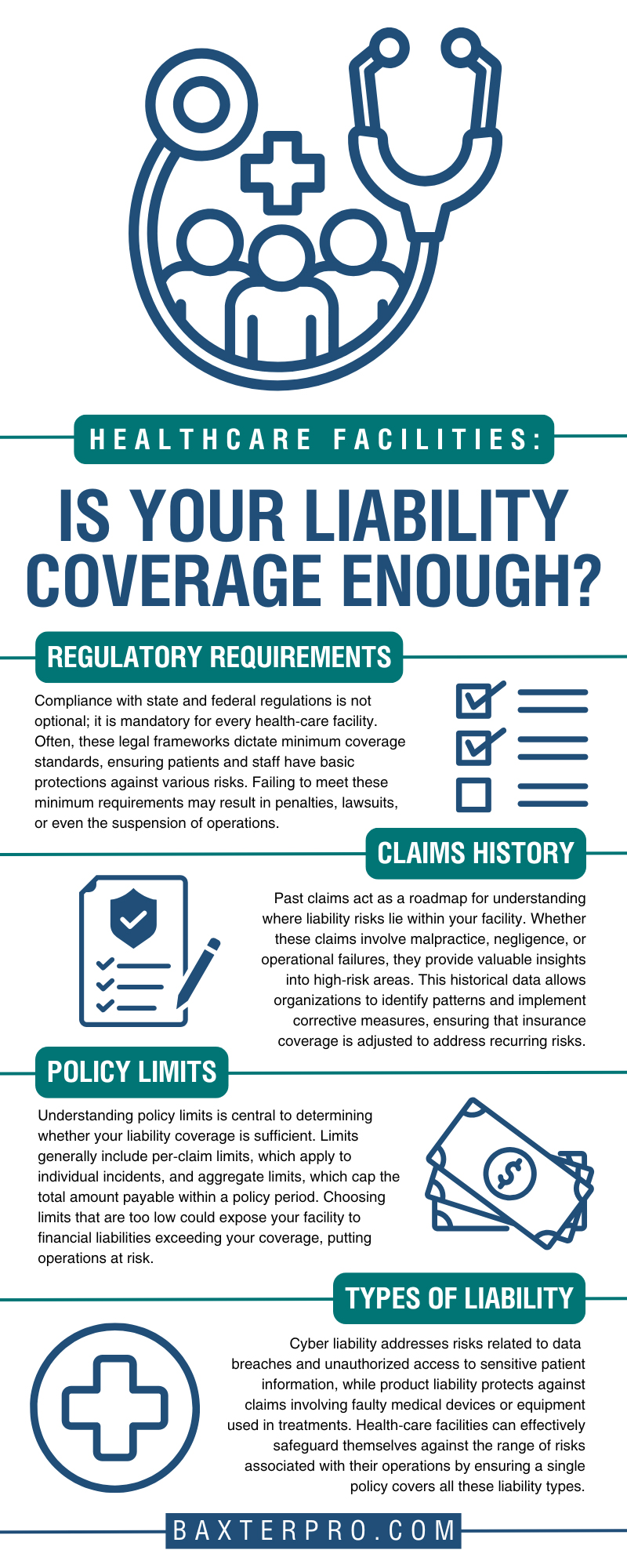Liability coverage is more than just insurance; it’s a safeguard against financial and reputational devastation for health-care facilities. From patient care to operational oversight, the complexities and array of risks may leave you wondering whether your health-care facility’s liability coverage is enough. Consider the limitations of your current coverage and whether it aligns with the scope, challenges, and evolving demands of the health-care industry.
Regulatory Requirements
Compliance with state and federal regulations is not optional; it is mandatory for every health-care facility. Often, these legal frameworks dictate minimum coverage standards, ensuring patients and staff have basic protections against various risks. Failing to meet these minimum requirements may result in penalties, lawsuits, or even the suspension of operations.
In addition to meeting these standards, facilities must stay updated on regulatory changes. Legislation often evolves, introducing new requirements for liability coverage. Facilities should collaborate with their insurers to adapt to these changes, ensuring uninterrupted compliance and comprehensive protection.
Claims History
Past claims act as a roadmap for understanding where liability risks lie within your facility. Whether these claims involve malpractice, negligence, or operational failures, they provide valuable insights into high-risk areas. This historical data allows organizations to identify patterns and implement corrective measures, ensuring that insurance coverage is adjusted to address recurring risks.
For example, a health-care facility with a history of malpractice claims related to diagnostic errors may benefit from coverage emphasizing professional liability. Often, high-quality insurers provide an analysis of a facility’s claims history to help refine their policies and implement preventive strategies.
Policy Limits
Understanding policy limits is central to determining whether your liability coverage is sufficient. Limits generally include per-claim limits, which apply to individual incidents, and aggregate limits, which cap the total amount payable within a policy period. Choosing limits that are too low could expose your facility to financial liabilities exceeding your coverage, putting operations at risk.
Health-care administrators should carefully assess their facilities’ exposure to high-cost claims. Often, maternity care, surgical specialties, emergency medicine and similar sectors involve costly lawsuits. Adequate limits offer financial security in such scenarios, ensuring the facility remains operational even in the face of substantial claims.
Types of Liability
Liability risks in health care extend beyond general malpractice, necessitating comprehensive insurance coverage to address a diverse range of challenges and risks. General liability insurance protects against non-patient-related claims, such as accidents that occur on the premises. Professional liability, such as group malpractice insurance, specifically covers claims arising from errors or omissions in the delivery of medical care.
Cyber liability addresses risks related to data breaches and unauthorized access to sensitive patient information, while product liability protects against claims involving faulty medical devices or equipment used in treatments. Health-care facilities can effectively safeguard themselves against the range of risks associated with their operations by ensuring a single policy covers all these liability types.
Patient Volume
The volume of patients treated in your facility has a significant impact on liability exposure. A higher patient count increases the likelihood of incidents leading to claims. Policies and coverage limits should scale proportionally to patient traffic to ensure adequate protection.
Facilities must regularly evaluate patient volume trends to ensure optimal utilization of resources. If patient numbers rise consistently, so should coverage. Underestimating the impact of volume on liability can leave the facility financially exposed, even if other aspects of the policy are well-structured.
Scope of Services Provided
Every health-care facility operates within a unique scope of services, whether it’s outpatient care, specialized surgery, or diagnostic testing. This scope impacts your risk exposure and, consequently, the liability coverage you need.
For instance, a hospital offering high-risk surgeries will face far greater liability risks than a clinic providing routine wellness exams, making it very important to know whether your health-care facility’s liability coverage is enough.
Insurance coverage must align with the services your facility offers. A mismatch in coverage can leave facilities vulnerable should a claim arise. Administrators must thoroughly evaluate their service offerings and confirm their insurance policy addresses the specific risks associated with those services. Customization is key when it comes to effectively mitigating liability.
Exclusions and Limitations
No insurance policy is without exclusions. These are specific scenarios or categories of risk that the policy does not cover. Understanding these exclusions is vital to avoid unexpected gaps in protection. Reviewing exclusions with your insurer can help you identify areas where supplementary coverage may be necessary. Knowing what your policy doesn’t cover allows you to make informed decisions and protect your facility against avoidable risks.
Staffing and Credentials
The credentials and number of staff within your facility directly influence liability risks. Highly trained and certified professionals contribute to lower risk levels, while underqualified or temporary staff can elevate exposure. Often, policies take these factors into account, affecting premiums and the extent of coverage.
Facilities should prioritize staff training, conduct regular credential audits, and ensure all health-care workers meet industry standards to minimize risks. A fully qualified team reduces internal risks and may lead to more favorable insurance terms and premiums.
Emerging Risks
Technological advancements and societal shifts introduce new risks that health-care facilities cannot afford to ignore. For instance, telemedicine expands access to care but introduces compliance and cybersecurity challenges.
Similarly, data breaches and hacking attempts are on the rise within the health-care sector, putting sensitive patient data at risk. Liability coverage must adapt to these emerging challenges. Policies addressing telemedicine liability, cyber threats, and similar concerns are no longer optional—they are indispensable. Forward-thinking health-care administrators must actively seek policy adjustments to cover such risks and protect their facilities in the modern landscape.
Legal Defense Costs
Legal defense costs can be a significant financial burden during liability claims. The cost of hiring attorneys, expert witnesses, and handling legal procedures can quickly escalate, even in instances where the case is dismissed.
Adequate liability insurance should explicitly include coverage for these defense costs, reducing the facility’s out-of-pocket financial strain.
Confirming your policy’s inclusion of legal defense costs ensures peace of mind through complex legal battles. This often-overlooked aspect of liability coverage can make the difference between financial stability and operational difficulty during challenging legal disputes.
Choosing the Right Coverage
Assessing liability coverage is not merely a matter of compliance but rather a strategic decision affecting your health-care facility’s health and stability. Understanding regulatory obligations, navigating legal defense costs, and considering all possible risks and coverage limitations allow you to seek the most comprehensive liability insurance. The financial protection and peace of mind it offers is crucial.
Consider consulting experts in medical liability insurance for customized advice on crafting a liability coverage plan tailored to your facility’s unique needs. Agencies like Baxter & Associates have years of experience specializing in helping health-care facilities find comprehensive, competitively priced coverage. Taking proactive steps today provides long-term security for your staff, patients, and overall operations.
















